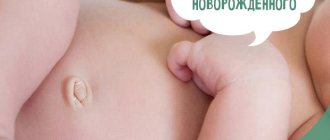November 29, 2016
Averyanova Sveta
The appearance and rate of growth of the navel in newborns is an important indicator of the child’s health and the level of attention of the parents. Normally, the wound will heal by the end of the baby’s first month of life and will not cause much trouble for moms and dads. What to do if a newborn’s belly button bleeds and does not heal for a long time? Find out from our article.
Causes
A bloody navel in children immediately after birth and for about 2 weeks is considered normal. By the month it will heal, treatment and additional care of the navel will not be required. If the navel of a newborn bleeds for more than 4 weeks, you need to find out the cause of the pathological condition.
The key factors for a bloody navel may be:
- Thick skin. It is rare, but takes 1-2 weeks longer to heal. There is no danger for the baby.
- Improper care of the umbilical wound. This is overzealous care or lack of attention to the site of the umbilical cord falling off. Do not roughly treat the wound, use alcohol, or seal it, protecting it from water, bacteria and air.
- Rubbing with clothes, diapers. The wound cannot heal due to friction or tearing off the crust by the edges of panties, shirts, and fasteners. Do not fully equip your baby at home for the first weeks after birth; air baths are beneficial for him; wear clothes without seams made of soft fabric.
- Congenital pathologies. This is fragility of blood vessels, low blood clotting.
- Granuloma (umbilical fungus). At the bottom of the umbilical wound, a layer of skin grows, and nodules form focally. It looks like a mushroom.
- Umbilical hernia.
The navel protrudes and becomes larger when crying or coughing. Surgeon's help is required. - Foreign body inside the wound. You can feel it yourself, but picking and pulling it out at home is prohibited.
- Infection. Accompanied by suppuration and an unpleasant odor. If there is pus discharge or inflammation, you need to go to the clinic urgently, otherwise there will be sepsis.
- Blood diseases. Infection occurs in the womb or immediately after birth; the baby’s immunity cannot cope with wound healing.
Compare what a healthy navel looks like in a two-week-old baby and a wound with a granuloma:
Why does a newborn's belly button bleed?
You should not worry if healing proceeds quickly, and the umbilical wound bleeds only with accidental movement, if the edge of the formed crust comes off after bathing or stretching the ring surrounding the residual process. In this case, only a few drops of plasma are released, and everything dries out again.
A list of more dangerous reasons why a baby’s navel bleeds:
- careless actions when changing a diaper - systematically tearing off the crust;
- the umbilical cord was too thick, causing regeneration to be slow;
- due to an obstetric error - the remaining umbilical cord is too short or too long;
- the newborn's wound is bleeding due to problems with blood clotting;
- increased fragility of blood vessels;
- reduced infant immunity caused by prematurity or organic diseases;
- allergy to treatment products;
- the scab develops because the baby is overheated;
- in the open wound, blood vessels grow, granulation occurs (visually it looks like a red ball in the umbilical cavity), and when placed on the stomach or touched, the navel bleeds;
- too delicate skin, irritated when using preparations with ethyl alcohol, which causes healing to be delayed;
- inexperienced parents peel off the flaky, dried edges of the scab;
- for bathing they use too hot water or wipe the entire body with a hard washcloth, the crust gets wet after bathing and comes off.
If a scab has formed over the wound, and then the navel suddenly begins to bleed, and the child becomes restless, you need to consult a pediatrician. Long healing is dangerous. When suppuration occurs, an infection may enter the wound. In children in the first months of life, metabolic processes are accelerated, pathogenic microorganisms quickly spread throughout the body - there is a high risk of developing sepsis. The most dangerous is Staphylococcus aureus.
How long can a belly button bleed?
The healing time for a wound in a baby is 10-21 days, and complete healing can last 40-45 days. This is considered the norm.
Important information: What to do if a wart bleeds and how to stop the bleeding
The residual umbilical cord, which is a nodule, falls off 7-10 days after birth. The wound may bleed for a long time, it is deep, but within 5-6 days a dense scab will form. It gradually becomes thinner, starting from the edges, peels off, and there is little discharge. The color of the liquid that flows out when the crust peels off is yellowish-pink. If you damage the scab, blood will start flowing from the navel again, and healing will be delayed.
How to understand that there is an infection
Moms can notice an infection in their baby’s navel by the following signs:
- The navel becomes very wet and bleeds for more than 3-4 weeks after the birth of the baby.
- There is pus, it may not be released on its own, but it will flow out when pressed with ichor.
- The navel is covered with a purulent scab.
- The surrounding skin swells.
- The baby reacts painfully to touching his tummy and begins to scream and cry.
A bacterial disease of the umbilical wound is called omphalitis.
If it is not treated on time, the child will face serious consequences.
When you urgently need to see a doctor
In principle, a “wet” navel is always an indication for contacting a pediatrician. It doesn’t matter what the pathology is called - omphalitis, fistula or phlegmon, an emergency situation can arise at any time. If parents notice the following changes, they should urgently call a doctor:
- the color of the skin around the navel is red or bluish;
- more ichor began to be released than usual;
- the exudate looks different: the color has changed (yellow, dark gray, brown), its consistency (more viscous, mixed with blood), the navel has begun to smell bad or stink of urine or feces;
- severe pain appeared in the navel area;
- swelling of the tissues of the peri-umbilical region has increased;
- there are signs of general malaise and intoxication.
If the wound begins to rot, this is a real threat to the baby’s life. From the abscess, the infection can instantly spread throughout the baby’s entire body.
If, during an uncomplicated course, ichor continues to flow from the umbilical wound after 3 weeks, this is also a reason for an urgent visit to the doctor.
What do we have to do
The navel in newborns is the weakest point. Before the “tail” falls off in the maternity hospital, obstetricians treat the wound with hydrogen peroxide and brilliant green. After 3-4 days, before discharge home, the clothespin is removed, and parents need to continue medical procedures at home.
If the navel does not bleed or gets wet just a little, it is enough for the mother to carry out the following procedures 1-2 times daily:
- Bath the baby in warm water with herbs.
- Dry your body and navel with a towel.
- Fill the wound with hydrogen peroxide. Wait for her to hiss.
- Coat the skin around the wound with brilliant green using a cotton swab.
- There is no need to cover it with adhesive tape.
If the clothespin does not want to fall off for a long time, the wound bleeds a month after discharge, the parents’ action algorithm is as follows:
- Complain about a suspicious symptom to a doctor.
- Stop bathing temporarily. The doctor will tell you how many days the child should not be washed and the appearance of the wound. Wiping with wet wipes is not prohibited.
- Dry the navel with brilliant green. Using a tampon.
- Remove crusts and purulent accumulations from above, without penetrating deep into the wound.
- Lubricate with antibacterial ointments as prescribed by your pediatrician.
- Allow the bloody wound to bake and peel off on its own. It is impossible to forcefully remove the remainder of the sore; the wound may bleed again.
What to do after the umbilical cord has fallen off?
This can happen both in the maternity hospital and after discharge home.
Currently, pediatricians recommend not touching the wound. But, to be honest, the sight sometimes scares mommies.
After the umbilical cord has fallen off, blood clots, ichor, and crusts may remain in the umbilical wound. It may also bleed.
If blood crusts accumulate, the wound area can be treated with hydrogen peroxide and cauterized on top with an alcohol solution of salicylic acid.
These procedures can be done until the wound is completely healed.
What not to do
If the umbilical wound oozes heavily and the bleeding does not stop well, be careful and take precautions when caring for your baby. The following manipulations are strictly prohibited:
- Treat the healing area more than 2 times a day. Don’t forget that a baby’s skin is delicate, it can easily be burned with brilliant green.
- Wash the umbilical wound with scented soap. To dry the wound, use baby or laundry soap in small doses.
- Cover the wound with a bandage and cover it with a diaper. The navel needs air to heal, do not hide it under multi-layered clothing.
- Self-medicate and make a diagnosis without consulting a doctor.
Do not apply ointments to a bleeding, purulent wound unless prescribed by a pediatrician; this is dangerous for the child. - Pick out the dried crust over the navel. The wound began to heal, so a sore formed. If you pick it out, bleeding will begin and the navel will become inflamed.
- Take time when treating the navel, for fear of causing pain to the baby. Carry out preventive procedures confidently and quickly, so the baby will not feel discomfort and will not freeze.
- Place on the tummy until the wound is completely healed. This position is allowed for children closer to 3 months. If exposed early, the wound will stretch and become constantly inflamed.
What to do with the umbilical cord at home?
Many mothers, when they see their baby’s umbilical cord for the first time, are afraid to touch it. They think that this will bring discomfort to the child. Not really. There are no pain receptors in the umbilical cord, so manipulations with the “navel” are absolutely painless.
When caring for the umbilical cord in newborns, you need to follow 3 basic rules.
- Do not leave residue under the diaper. If the umbilical cord remains under it, it begins to rot and smell unpleasant. Therefore there is no need to do this. If you put a diaper on your newborn, try to do it with a clip.
- When carrying out water procedures, wet as little as possible. Although they say that you can bathe a child with the umbilical cord remnant, in practice such navels take much longer to fall off than with the dry method. In addition, they can rot.
- You should not treat “normal” umbilical cord residue with hydrogen peroxide or brilliant green. This won't lead to anything, and it won't fall off any faster.
Here I would like to quote Dr. Komarovsky: “The use of strong antiseptics prevents the proliferation of bacteria that are responsible for the process of “drying out the navel.”
Bathing
Pay special attention to bath procedures during the healing period of the umbilical wound. Bathe your newborn only in boiled water without soap or bubble bath. As a therapeutic and preventive supplement to get rid of inflammation and peeling of the skin, you can use herbal infusions of chamomile, string, celandine, and a weak solution of potassium permanganate.
If the baby's navel bleeds slightly, there is no need to change the daily routine. If pus or symptoms of infection are detected in the wound, bathing should be canceled and go to the doctor for help.
Important! After the bath, be sure to wait for the umbilical wound to dry. Wet skin cannot be treated with antiseptics.
How to treat a newborn's navel?
In the first days of life, the baby requires special care. Fortunately, even first-time mothers very quickly become real professionals in this complex matter and confidently carry out all the necessary procedures. They are usually shown how to treat a newborn’s navel in the maternity hospital. If a pregnant woman wants to learn about all the intricacies of this procedure before giving birth, then she should carefully read the following tips:
- The newborn's navel is treated daily until complete healing, and this is done after bathing.
- To properly treat the navel, young parents need to acquire hydrogen peroxide, cotton swabs, disinfectant (brilliant) and a pipette.
- Each time after bathing the baby, using a sterilized pipette, drop hydrogen peroxide onto the umbilical wound and wait about a minute until the liquid stops foaming. After that, softened yellow or bloody crusts are carefully removed with a cotton swab.
- When treating the navel daily, you should try to remove all the crusts, even if they are in hard-to-reach places, since bacteria can multiply under them.
- At the end of each procedure, the umbilical wound should be lubricated with brilliant green.
When peroxide dropped into the newborn's navel stops foaming, daily treatment procedures can be stopped. If a newborn’s navel does not heal even after the baby is one month old, then you should consult a pediatrician and think about more serious treatment.










